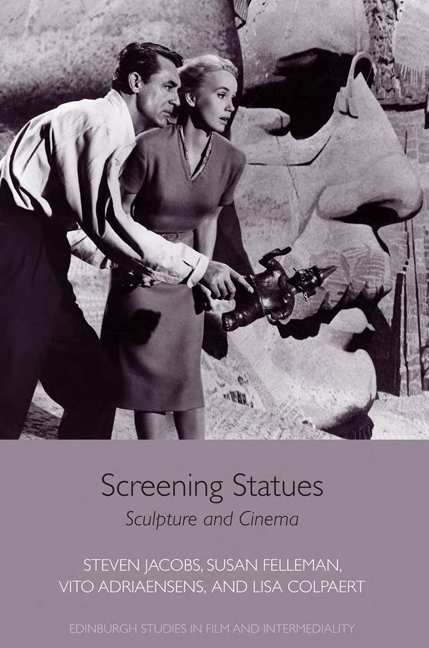Book contents
- Frontmatter
- Contents
- List of Figures
- Acknowledgements
- Introduction: The Marble Camera
- PART I
- 1 The Sculptor's Dream: Living Statues in Early Cinema
- 2 The Mystery … The Blood … The Age of Gold: Sculpture in Surrealist and Surreal Cinema
- 3 Carving Cameras on Thorvaldsen and Rodin: Mid-Twentieth- Century Documentaries on Sculpture
- 4 Anatomy of an Ovidian Cinema: Mysteries of the Wax Museum
- 5 The Night of the Human Body: Statues and Fantasy in Postwar American Cinema
- 6 From Pompeii to Marienbad: Classical Sculptures in Postwar European Modernist Cinema
- 7 Of Swords, Sandals, and Statues: The Myth of the Living Statue
- 8 Coda: Returning the Favor (A Short History of Film Becoming Sculpture)
- PART II
- Bibliography
- About the Authors
- Index
6 - From Pompeii to Marienbad: Classical Sculptures in Postwar European Modernist Cinema
from PART I
Published online by Cambridge University Press: 23 June 2018
- Frontmatter
- Contents
- List of Figures
- Acknowledgements
- Introduction: The Marble Camera
- PART I
- 1 The Sculptor's Dream: Living Statues in Early Cinema
- 2 The Mystery … The Blood … The Age of Gold: Sculpture in Surrealist and Surreal Cinema
- 3 Carving Cameras on Thorvaldsen and Rodin: Mid-Twentieth- Century Documentaries on Sculpture
- 4 Anatomy of an Ovidian Cinema: Mysteries of the Wax Museum
- 5 The Night of the Human Body: Statues and Fantasy in Postwar American Cinema
- 6 From Pompeii to Marienbad: Classical Sculptures in Postwar European Modernist Cinema
- 7 Of Swords, Sandals, and Statues: The Myth of the Living Statue
- 8 Coda: Returning the Favor (A Short History of Film Becoming Sculpture)
- PART II
- Bibliography
- About the Authors
- Index
Summary
Men, Women, and Statues
The statue is a significant motif in many key films of the European modernist cinema of the 1950s and 1960s. Famous examples are Les Statues meurent aussi (Alain Resnais and Chris Marker, 1953), Viaggio in Italia (Roberto Rossellini, 1953), L‘Année dernière à Marienbad (Alain Resnais, 1961), La Jetée (Chris Marker, 1962), Jules et Jim (François Truffaut, 1962), Méditerranée (Jean-Daniel Pollet, 1963), Le Mépris (Jean-Luc Godard, 1963), Il Gattopardo (Luchino Visconti, 1963), Une Femme mariée (Jean-Luc Godard, 1964), Gertrud (Carl Theodor Dreyer, 1964), and Vaghe stelle dell‘orsa (Luchino Visconti, 1965). Focusing on Rossellini's Viaggio in Italia (Journey to Italy, 1953) and Resnais’ L‘Année dernière à Marienbad (Last Year in Marienbad, 1961) as cases in point, this chapter not only traces the fascination for sculpture in modernist cinema but also explains it by examining the ways in which statues are presented as tokens of death, time, history, myth, memory, the human body, and strategies of doubling – important topics for many of the leading modernist directors working in the 1950s and 1960s.
Roberto Rossellini's Viaggio in Italia tells the story of Katherine and Alexander Joyce (Ingrid Bergman and George Sanders), an uptight English couple whose troubled marriage reaches a crisis when they travel to Naples to settle the estate of a deceased relative. The film's loose plot is structured around a series of excursions Katherine takes to famous tourist sites, among which is the National Archaeological Museum that hosts an extensive col¬lection of Greek and Roman statues. As Bergman remembers in her autobi¬ography, the first two weeks of shooting consisted of her “staring at ancient statues in the Naples Museum while an equally ancient guide bumbled on about the glories of Greece and Rome.” The guide in fact shows Katherine world-renowned masterpieces of classical sculpture such as several of the so-called Farnese marbles, a Venus statue, busts of Roman emperors, and some bronze sculptures from Herculaneum.
- Type
- Chapter
- Information
- Screening StatuesSculpture and Cinema, pp. 118 - 136Publisher: Edinburgh University PressPrint publication year: 2017



